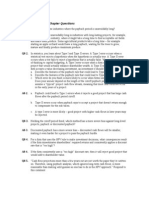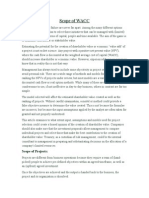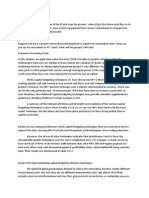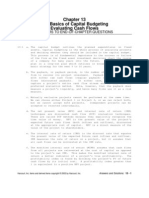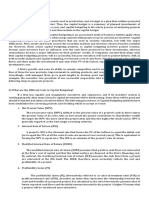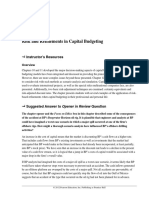Capital Budgeting - IMPORTANT PDF
Capital Budgeting - IMPORTANT PDF
Uploaded by
salehin1969Copyright:
Available Formats
Capital Budgeting - IMPORTANT PDF
Capital Budgeting - IMPORTANT PDF
Uploaded by
salehin1969Original Description:
Original Title
Copyright
Available Formats
Share this document
Did you find this document useful?
Is this content inappropriate?
Copyright:
Available Formats
Capital Budgeting - IMPORTANT PDF
Capital Budgeting - IMPORTANT PDF
Uploaded by
salehin1969Copyright:
Available Formats
Chapter 9 Cash Flow and Capital Budgeting
Answers to Concept Review Questions
1. Why is it important for the financial analyst to (a) focus on incremental cash flows, (b) ignore financing costs, (c) consider taxes, and (d) adjust for non-cash expenses when estimating a projects relevant cash flows? a. To properly evaluate the costs and benefits of a capital investment project, a manager must be able to identify the additional cash inflows and outflows that will result solely from acceptance of the project, so only these incremental CFs are important. b. An analyst should ignore financing costs for individual projects, and instead should use a single weighted average cost of capital for evaluating all capital investment projects that have the same risk as the firms other assets. Otherwise, the analysts will be entangling investment and capital structure (the mix of long-term debt and equity) decisions. c. Taxes influence the capital budgeting decision because they can change the net value of cash flows received or paid out that result from accepting a project. Taxes on cash inflows reduce the value of these receipts, while tax credits and deductions that result from accepting a project increase its attractiveness. d. Non-cash expenses are important if these reduce the taxes that must be paid on incremental cash inflows. The most important non-cash expense for most firms is depreciation, and this deduction works to reduce the tax liabilities of profitable firms. 2. Why do we consider changes in net working capital associated with a project to be cash inflows or outflows rather than the absolute level of working capital? Changes in net working capital are important. The company starts out with a certain amount of working capital since it already has this, it is not relevant to the cash flow equation. If it needs to change the amount of working capital that it has, then that change is relevant. 3. For what kinds of investments would terminal value account for a substantial fraction of the total project NPV, and for what kinds of investments would terminal value be relatively unimportant? The higher the growth rate of cash flows, the higher the terminal value of the project. A project where cash flows level off in time will have a much smaller terminal value. 4. What is meant by a potential investments relevant cash flows? What are sunk costs and cannibalization, and do they affect the process of determining a proposed investments incremental cash flows? The relevant cash flows for an investment are its incremental, after-tax, cash flows, which ignore financing costs and reflect adjustments for any noncash charges, typically depreciation.
41
42
� Chapter 9/Cash Flow and Capital Budgeting
A sunk cost is a cost that has already been paid and is therefore not recoverable. Cannibalization is the substitution effect that frequently occurs when a firm introduces a new product. Typically, some of the new products sales will come at the expense of the firms existing products. While sunk costs are irrelevant and should be ignored when determining an investments incremental cash flows, the incremental cash outflows from existing product sales that are cannibalized by a newer product should be taken into consideration when considering a new investment. 5. A real estate development firm owns a fully leased 40-story office building. A tenant recently moved its offices out of 2 stories of the building, leaving the space temporarily vacant. If the real estate firm considers moving its own offices into this 40-story office building, what cost should it assign for the space? Is the cost of the vacant space zero because the firm paid for the building long ago, a cost that is sunk, or is there an incremental opportunity cost? The cost for the space is the opportunity cost of not renting it out to a new tenant. It will lose the rentals it could have gained if it chooses to occupy the space with its own offices 6. Suppose that an analyst makes a mistake and calculates the NPV of an investment project by discounting the projects contribution to net income each year rather than by discounting its relevant cash flows. Would you expect the NPV based on net income to be higher or lower than the NPV calculated using the relevant cash flows? NPV based on net income could be higher if the company has low depreciation and high additional working capital and ongoing capital expenditures needed for the project. NPV based on net income could be lower if the company had a substantial depreciation expense that was not added back into cash flows. 7. Embedded in the analysis of the jazz-music CD proposal is an assumption about how Classicaltunes.coms customers will behave when they are able to choose from a new set of CDs. What is that assumption? The company is assuming that its customers will see value in the addition of jazz CDs and will add jazz to their classical sections. Any customers choice to buy jazz instead of a classical CD must be embedded in the incremental cash flows. 8. What other ways might Classicaltunes.com estimate the terminal value of this project? Classicaltunes.com could have assumed a stable perpetuity, rather than a growing perpetuity, which would have given it a lower terminal value. 9. Suppose that Congress passes a new MACRS schedule that reclassifies computers as 3year equipment rather than 5-year equipment. In general, what impact would this legislation have on the projects NPV? This change would be an advantage to companies. They would be able to depreciate their purchases faster, meaning there will be more depreciation, less taxable income and therefore less in taxes. It is to a companys benefit to depreciate equipment as quickly as possible. In fact, assuming it had sufficient income, it would receive the most benefit by not depreciating equipment, and simply expensing it when it occurred.
Chapter 9/Cash Flow and Capital Budgeting
� 43
10.
When a firm is faced with capital rationing, how can the profitability index (PI) be used to select the best projects? Why doesnt choosing the projects with the highest PI always lead to the best decision? When managers are constrained by the availability of funds and they cannot invest in every project that has a positive NPV, they face the so-called capital-rationing. Whenever managers have to choose from a set of possible investments they must choose a combination of projects that maximizes shareholder wealth, subject to the constraint of limited funds. The PI is very functional in such situations. Once managers rank projects, they select the investment with the highest PI. If the total amount of capital available has not been fully exhausted, then managers invest in the project with the second-highest PI, and so on until no more capital remains to invest. By following this routine, managers will select a portfolio of projects that in aggregate generates a higher NPV than any other combination of projects. However, this method may not maximize shareholder wealth when capital is rationed not only at the beginning of an investments life, but also in all subsequent periods. This method can also lead to suboptimal decisions when projects are interdependentthat is, when one investment is contingent on another.
11.
Under what circumstance is the use of the equivalent annual cost (EAC) method to compare substitutable projects with different lives clearly more efficient computationally than using multiple investments over a common period where both projects terminate in the same year? Using equivalent annual cost is more efficient when it would take a large number of repetitions of the NPV calculations in order to find a value. For example, suppose one project lasts 11 years and a second project lasts 13 years. You would have to replicate this project over a 13 x 11 = 143 years in order to find a common time horizon
12.
In almost every example so far, firms must decide to invest in a project immediately or not at all. But suppose that a firm could invest in a project today or it could wait one year before investing. How could you use NPV analysis to decide whether to invest now or later? You could compute two NPVs now and a year from now, with appropriate changes in the cash flows. You could also look at the opportunity cost of investing now vs. later. If the company chooses to wait a year, are there projects it could fund now and still be able to receive positive NPV from the original project if it began it in a year? If so, then waiting could be the best decision.
13.
Can you articulate circumstances under which the cost of excess capacity is zero? Think about why the cost of excess capacity normally is not zero. The cost of excess capacity would be zero if there were no current or future uses for that excess capacity. For example, if sales in the original product were not expected to increase, or perhaps even decline, so therefore the original product would never be able to make use of the excess capacity.
14.
What role does the human element play in the capital budgeting decision process? Could it cause a negative-NPV project to be accepted? Managers tend to be favorably biased toward projects stemming from their own ideas. They may consciously or unconsciously manipulate the projects they favor to show
44
� Chapter 9/Cash Flow and Capital Budgeting
positive cash flows when in fact such results might be questionable. This optimism could cause a negative NPV project to be accepted.
Answers to Self-Test Problems
ST9-1. Claross, Inc. wishes to determine the relevant operating cash flows associated with the proposed purchase of a new piece of equipment having an installed cost of $10 million and falling into the 5-year MACRS asset class. The firms financial analyst estimated that the relevant time horizon for analysis is 6 years. She expects the revenues attributable to the equipment to be $15.8 million in the first year and to increase at 5% per year through year 6. Similarly, she estimates all expenses other than depreciation attributable to the equipment to total $12.2 million in the first year and to increase by 4% per year through year 6. She plans to ignore any cash flows after year 6. The firm has a marginal tax rate of 40% and its required return on the equipment investment is 13%. (Note: Round all cash flow calculations to the nearest $0.01 million.) a. Find the relevant incremental cash flows for years zero through 6. b. Using the cash flows found in part a, determine the NPV and IRR for the proposed equipment purchase. c. Based on your findings in part b, would you recommend that Claross, Inc. purchase the equipment? Why? a. Year Initial Investment Revenue (+5%/yr) Expenses (+4%/yr EBDT -Depreciation EBT -Taxes (40%) EAT +Depreciation Total Cash Flow NPV at 13% IRR 0 -10 15.80 12.20 3.60 2.00 1.60 0.64 0.96 2.00 2.96 16.59 12.69 3.90 3.20 0.70 0.28 0.42 3.20 3.62 17.42 13.20 4.22 1.92 2.30 0.92 1.38 1.92 3.30 18.29 13.72 4.57 1.15 3.42 1.37 2.05 1.15 3.20 19.21 14.27 4.94 1.15 3.79 1.52 2.27 1.15 3.42 20.17 14.84 5.33 0.58 4.75 1.90 2.85 0.58 3.43 1 ($million) 2
-10 3.21 24%
Accept the project because the NPV is greater than zero and the IRR is greater than 13%
*
Depreciation schedule
Chapter 9/Cash Flow and Capital Budgeting
� 45
Year 1 2 3 4 5 6
(1) Rate(from Table 9.1) 0.2000 0.3200 0.1920 0.1152 0.1152 0.0576
(2) Cost 10.0 10.0 10.0 10.0 10.0 10.0 Total
(3) [(1) x (2)] Depreciation 2.00 3.20 1.92 1.15 1.15 0.58 10.00
ST9-2. Atech Industries wishes to determine whether it would be advisable for it to replace an existing, fully depreciated machine with a new one. The new machine will have an aftertax installed cost of $300,000 and will be depreciated under a 3-year MACRS schedule. The old machine can be sold today for $80,000 after taxes. The firm is in the 40% marginal tax bracket and requires a minimum return on the replacement decision of 15%. The firms estimates of its revenues and expenses (excluding depreciation) for both the new and old machine (in $thousands) over the next 4 years are given below. Year 1 2 3 4 Revenue $ 925 990 1,000 1,100 New Machine Expenses(excl. depr) $740 780 825 875 Revenue $625 645 670 695 Old Machine Expenses(excl. depr.) $580 595 610 630
Atech also estimated the values of various current accounts that would be impacted by the proposed replacement. They are shown below for both the new and old machine over the next four years. Currently (at time 0) the firms net investment in these current accounts is assumed to be $110,000 with the new machine and $75,000 with the old machine. NEW MACHINE Year Cash Accounts Rec. Inventory Accounts Pay OLD MACHINE 1 $15,000 60,000 45,000 33,000 Year 2 $15,000 64,000 48,000 35,000 3 $15,000 68,000 52,000 38,000 4 $15,000 70,000 55,000 40,000 1 $20,000 90,000 80,000 60,000 2 $25,000 95,000 90,000 65,000 3 $ 30,000 110,000 100,000 70,000 4 $ 36,000 120,000 105,000 72,000
Cash Accounts Rec. Inventory Accounts pay.
46
� Chapter 9/Cash Flow and Capital Budgeting
Atech estimates that after 4 years of detailed cash flow development, it will assume in analyzing this replacement decision that the year 4 incremental cash flows of the new machine over the old machine will grow at a compound annual rate of 2% from the end of year 4 to infinity. a. Find the incremental operating cash flows (including any working capital investment) for years 1 to 4 for Atechs proposed machine replacement decision. b. Calculate the terminal value of Atechs proposed machine replacement at the end of year 4. c. Show the relevant cash flows (initial outlay, operating cash flows, and terminal cash flow) for years 1 to 4 for Atechs proposed machine replacement. d. Using the relevant cash flows from part c, find the NPV and IRR for Atechs proposed machine replacement. e. Based on your findings in part d, what recommendation would you make to Atech regarding its proposed machine replacement? a. NEW MACHINE Investment Revenue -Expenses(excl. depr.) -Depreciation* EBT EAT [(1-0.40) x EBT] -W/C Investment** (1)Operating CF OLD MACHINE A/T Sale Proceeds +80,000 Revenue -Expenses(excl. depr.) -Depreciation EBT EAT [(1-0.40) x EBT] -W/C Investment*** (2)Operating CF INCR. CF[(1)-(2)] -220,000 * New Asset Depreciation Year 1 2 3 4
**
0 -300,000
1 925,000 740,000 99,990 85,010 51,006 20,000 31,006
2 990,000 780,000 133,350 76,650 45,990 15,000 30,990
Year 3 1,000,000 825,000 44,430 130,570 78,342 25,000 53,342
4 1,100,000 875,000 22,230 202,770 121,662 19,000 102,662
625,000 580,000 0 45,000 27,000 12,000 15,000 16,006
645,000 595,000 0 50,000 30,000 5,000 25,000 5,990
670,000 610,000 0 60,000 36,000 5,000 31,000 22,342
695,000 630,000 0 65,000 39,000 3,000 36,000 66,662
Rate .3333 .4445 .1481 .0741
Cost $300,000 300,000 300,000 300,000
Depreciation $ 99,990 133,350 44,430 22,230
New Machine Working Capital Investment
Chapter 9/Cash Flow and Capital Budgeting
� 47
NWC= Cash + Accounts Receivable + Inventory Accounts Payable NWC= NWC-[Prior years NWC] Year 1 NWC = $20,000+$90,000+$80,000-$60,000-[$110,000] = $20,000 Year 2 NWC = $25,000+$95,000+$90,000-$65,000-[$130,000] = $15,000 Year 3 NWC = $30,000+$110,000+$100,000-$70,000-[$145,000] = $25,000 Year 4 NWC = $36,000+$120,000+$105,000-$72,000-[$170,000] = $19,000 *** Old Machine Working Capital Investment NWC= Cash + Accounts Receivable + Inventory Accounts Payable NWC= NWC-[Prior years NWC] Year 1 NWC = $15,000+$60,000+$45,000-$33,000-[$75,000] = $12,000 Year 2 NWC = $15,000+$64,000+$48,000-$35,000-[$87,000] = $5,000 Year 3 NWC = $15,000+$68,000+$52,000-$38,000-[$92,000] = $5,000 Year 4 NWC = $15,000+$70,000+$55,000-$40,000-[$97,000] = $3,000 b. Year 5 Operating CF = $66,662 x (1+.02)1 = $67,995 Terminal Value at end of Year 4 = $67,995 = $523,038 0.15 - 0.02
c. Relevant Cash Flows Total Year 4 CF = $66,662 + $523,038 = $589,700 Year Cash Flow 0 -$220,000 1 16,006 2 5,990 3 22,342 4 589,700 d. NPV @ 15% = $150,301 IRR = 31.92% e. Atech should undertake the proposed machine replacement because the NPV of $150,301 is greater than $0 and the IRR of 31.92% is above the firms 15% required return. ST9-3. Performance, Inc. is faced with choosing between two mutually exclusive projects with differing lives. It requires a return of 12% on these projects. Project A requires an initial outlay at time 0 of $5,000,000 and is expected to require annual maintenance cash outflows of $3,100,000 per year over its 2-year life. Project B requires an initial outlay at time 0 of $6,000,000 and is expected to require annual maintenance cash outflows of $2,600,000 per year over its 3-year life. Both projects are acceptable investments and provide equal quality service. The firm assumes that the replacement and maintenance costs for both projects will remain unchanged over time. a. Find the NPV of each project over its life. b. Which project would you recommend based on your finding in part a? What is wrong with choosing the best project based on its NPV?
48
� Chapter 9/Cash Flow and Capital Budgeting
c. Use the equivalent annual cost (EAC) method to compare the two projects. d. Which project would you recommend based on your finding in part c? Compare and contrast this recommendation with the one you gave in part b. a. Project A NPV = -$10,239,158 Project B NPV = -$12,244,761 Project A would be recommended because it has the lower cost NPV. The problem with this comparison is that Project A provides service for only 2 years versus Project Bs 3-year service life. EAC for Project A = $6,058,490 EAC for Project B = $5,098,094 Project B is preferred based on its lower EAC, which means that when costs are viewed on an annual basis it is less expensive than Project A. This recommendation is superior to the one made in part b because by looking at annual cost it resolves the issue of differing service lives when the replacement and maintenance costs are assumed unchanged over time.
b.
c. d.
You might also like
- Chapter 6 - The Analysis of Investment ProjectsDocument16 pagesChapter 6 - The Analysis of Investment ProjectsAbdul Fattaah Bakhsh 1837065No ratings yet
- Case 11Document10 pagesCase 11Trương Quốc VũNo ratings yet
- CH 8Document18 pagesCH 8ahngehlah100% (3)
- Guideline Answers To The Concept Check Questions Chapter 8: Capital BudgetingDocument8 pagesGuideline Answers To The Concept Check Questions Chapter 8: Capital BudgetingDawn CaldeiraNo ratings yet
- Capital BudgetingDocument11 pagesCapital BudgetingRonak MehtaNo ratings yet
- In BusinessDocument6 pagesIn BusinessAli ButtNo ratings yet
- Sec e - Cma Part 2Document4 pagesSec e - Cma Part 2shreemant muniNo ratings yet
- Capital Budgeting at Birla CementDocument61 pagesCapital Budgeting at Birla Cementrpsinghsikarwar0% (1)
- A Comparative Analysis of Capital BudgetingDocument10 pagesA Comparative Analysis of Capital BudgetingTimNo ratings yet
- Seminar Manajemen KeuanganDocument8 pagesSeminar Manajemen KeuangannoviyanthyNo ratings yet
- FFM12, CH 13, IM, 01-08-09Document20 pagesFFM12, CH 13, IM, 01-08-09seventeenlopez100% (1)
- Reading 31Document1 pageReading 31Chauanh NguyenNo ratings yet
- BUS - 539 Capital - Budgeting - Wk.5Document10 pagesBUS - 539 Capital - Budgeting - Wk.5TimNo ratings yet
- A. The Importance of Capital BudgetingDocument34 pagesA. The Importance of Capital BudgetingMutevu SteveNo ratings yet
- Cash Flow Estimation and Risk Analysis: Answers To End-Of-Chapter QuestionsDocument26 pagesCash Flow Estimation and Risk Analysis: Answers To End-Of-Chapter QuestionsZyana AyuNo ratings yet
- Capital Investment DecisionDocument8 pagesCapital Investment DecisionKweku_Affir_Hayf_886No ratings yet
- Chap 11 Solutions of EOC ProblemsDocument29 pagesChap 11 Solutions of EOC ProblemsibrahimNo ratings yet
- Capital Budgeting: Questions & Answers Q18.1Document38 pagesCapital Budgeting: Questions & Answers Q18.1Japhary Shaibu67% (3)
- CAPITAL BUDGETINGDocument9 pagesCAPITAL BUDGETINGnavinNo ratings yet
- Net Present Value: Problems in Using IRR in Risk AnalysesDocument11 pagesNet Present Value: Problems in Using IRR in Risk AnalysesAndrew LeeNo ratings yet
- Chapter 9 Capital BudgetinDocument184 pagesChapter 9 Capital BudgetinKatherine Cabading InocandoNo ratings yet
- Gitman 12e 525314 IM ch10rDocument27 pagesGitman 12e 525314 IM ch10rSadaf ZiaNo ratings yet
- MBA 511 Final ReportDocument13 pagesMBA 511 Final ReportSifatShoaebNo ratings yet
- FFM Chapter 8Document5 pagesFFM Chapter 8Dawn CaldeiraNo ratings yet
- Definition of Capital BudgetingDocument6 pagesDefinition of Capital Budgetingkaram deenNo ratings yet
- Hellpfull 10 11Document18 pagesHellpfull 10 11Mehran MumtazNo ratings yet
- Chapter 18Document17 pagesChapter 18Adnan TousifNo ratings yet
- Definitions:: - T. HorngreenDocument9 pagesDefinitions:: - T. Horngreenkurtieee21No ratings yet
- CH 13 SolDocument32 pagesCH 13 SolSungho LeeNo ratings yet
- Capital Budgeting - Adv IssuesDocument21 pagesCapital Budgeting - Adv IssuesdixitBhavak DixitNo ratings yet
- Net Present Value: Capital Budgeting (Or Investment Appraisal) Is The Planning Process Used ToDocument4 pagesNet Present Value: Capital Budgeting (Or Investment Appraisal) Is The Planning Process Used TorohitwinnerNo ratings yet
- L1R32 Annotated CalculatorDocument33 pagesL1R32 Annotated CalculatorAlex PaulNo ratings yet
- Why Is The Time Value of Money So Important in Capital Budgeting Decisions?Document3 pagesWhy Is The Time Value of Money So Important in Capital Budgeting Decisions?jatinNo ratings yet
- PFS: Financial Aspect - Project Financing and EvaluationDocument31 pagesPFS: Financial Aspect - Project Financing and EvaluationBjoy DalisayNo ratings yet
- Cfin 09Document19 pagesCfin 09Azra MuftiNo ratings yet
- RABARA - Capital ManagementDocument2 pagesRABARA - Capital Managementjhon rayNo ratings yet
- Chaptert 10 HW SolutionsDocument79 pagesChaptert 10 HW SolutionsJoanne Mendiola100% (1)
- Solutions Manual: Introducing Corporate Finance 2eDocument30 pagesSolutions Manual: Introducing Corporate Finance 2eJeremiah100% (1)
- 03 - 20th Aug Capital Budgeting, 2019Document37 pages03 - 20th Aug Capital Budgeting, 2019anujNo ratings yet
- How Capital Budgeting WorksDocument4 pagesHow Capital Budgeting WorksBatoolNo ratings yet
- Chapter 12Document34 pagesChapter 12LBL_Lowkee100% (1)
- Capital Inv Appraisal Questions Notes PDFDocument6 pagesCapital Inv Appraisal Questions Notes PDFtaridanNo ratings yet
- Advanced Aspects of Capital BudgetingDocument16 pagesAdvanced Aspects of Capital BudgetingPa HabbakukNo ratings yet
- Chapter 10Document42 pagesChapter 10LBL_Lowkee100% (1)
- Capital Budgeing ReviewDocument20 pagesCapital Budgeing ReviewBalakrishna ChakaliNo ratings yet
- Capital Budgeting: Net Present ValueDocument3 pagesCapital Budgeting: Net Present Valuepratibha2031No ratings yet
- Project Classification:: Advantages of Net Present Value (NPV)Document5 pagesProject Classification:: Advantages of Net Present Value (NPV)Orko AbirNo ratings yet
- Cap Budge Questions & Answers DR MaphosaDocument38 pagesCap Budge Questions & Answers DR MaphosaCosta MusandipaNo ratings yet
- Capital BudgetingDocument31 pagesCapital BudgetingS LakshmiNo ratings yet
- 11 LasherIM Ch11Document26 pages11 LasherIM Ch11Goran Gothai80% (5)
- Fundamentals of Financial Management 13th Ed M 333 339Document7 pagesFundamentals of Financial Management 13th Ed M 333 339Millenia AdiniraNo ratings yet
- лекция 4Document13 pagesлекция 4dNo ratings yet
- Making Investment Decisions With The Net Present Value RuleDocument12 pagesMaking Investment Decisions With The Net Present Value RuleSudamBeheraNo ratings yet
- Applied Corporate Finance. What is a Company worth?From EverandApplied Corporate Finance. What is a Company worth?Rating: 3 out of 5 stars3/5 (2)
- Decoding DCF: A Beginner's Guide to Discounted Cash Flow AnalysisFrom EverandDecoding DCF: A Beginner's Guide to Discounted Cash Flow AnalysisNo ratings yet
- Innovation Killers: How Financial Tools Destroy Your Capacity to Do New ThingsFrom EverandInnovation Killers: How Financial Tools Destroy Your Capacity to Do New ThingsRating: 4 out of 5 stars4/5 (3)
- Summary of Michael J. Mauboussin & Alfred Rappaport's Expectations InvestingFrom EverandSummary of Michael J. Mauboussin & Alfred Rappaport's Expectations InvestingNo ratings yet
- 6847merger Acquisition DivisionDocument10 pages6847merger Acquisition Divisionsalehin1969No ratings yet
- The Value Added Tax and Supplementary Duty Act, 2012Document76 pagesThe Value Added Tax and Supplementary Duty Act, 2012Mohammad SaifNo ratings yet
- Equity Method of AccountingDocument4 pagesEquity Method of Accountingsalehin1969No ratings yet
- Ifrs Updates and Advanced Applications Seminar DecemberDocument1 pageIfrs Updates and Advanced Applications Seminar Decembersalehin1969No ratings yet
- 053846805X 228070 PDFDocument31 pages053846805X 228070 PDFsalehin1969No ratings yet
- Consolidation PDFDocument5 pagesConsolidation PDFsalehin1969No ratings yet
- Ex Right Issue PriceDocument6 pagesEx Right Issue Pricesalehin1969No ratings yet
- Message To Shareholders Consolidated Statement of Income Consolidated Balance Sheet Consolidated Statement of Cash Flows Notes To Consolidated Financial StatementsDocument1 pageMessage To Shareholders Consolidated Statement of Income Consolidated Balance Sheet Consolidated Statement of Cash Flows Notes To Consolidated Financial Statementssalehin1969No ratings yet
- Minutes AGMDocument4 pagesMinutes AGMsalehin1969No ratings yet
- Ar 2005 Financial Statements p55 eDocument3 pagesAr 2005 Financial Statements p55 esalehin1969No ratings yet
- Consolidated Fi Anders SvenssonDocument13 pagesConsolidated Fi Anders Svenssonsalehin1969No ratings yet
- Chap 006Document51 pagesChap 006kel458100% (1)
- Ifrs 10 2011 PDFDocument8 pagesIfrs 10 2011 PDFJoshua Capa FrondaNo ratings yet
- Capital Structure Decisions: Part I: Answers To Beginning-Of-Chapter QuestionsDocument24 pagesCapital Structure Decisions: Part I: Answers To Beginning-Of-Chapter Questionssalehin1969No ratings yet
- Applying IFRS 3 in Accounting For Business Acquisitions: - A Case StudyDocument70 pagesApplying IFRS 3 in Accounting For Business Acquisitions: - A Case Studysalehin1969No ratings yet


